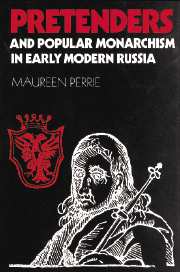Book contents
- Frontmatter
- Contents
- List of illustrations
- Preface
- Note on transliteration, names and dates
- Chronology of events
- Glossary of Russian terms
- List of abbreviations
- Introduction
- Prologue: Tsarevich Dimitry and Boris Godunov
- Part 1 The First False Dimitry
- Part 2 Rebels in the name of Tsar Dimitry
- Part 3 The final stages of the Troubles
- Epilogue: After the Troubles: pretence in the later seventeenth century
- Conclusion
- Bibliography
- Index
Epilogue: After the Troubles: pretence in the later seventeenth century
Published online by Cambridge University Press: 03 December 2009
- Frontmatter
- Contents
- List of illustrations
- Preface
- Note on transliteration, names and dates
- Chronology of events
- Glossary of Russian terms
- List of abbreviations
- Introduction
- Prologue: Tsarevich Dimitry and Boris Godunov
- Part 1 The First False Dimitry
- Part 2 Rebels in the name of Tsar Dimitry
- Part 3 The final stages of the Troubles
- Epilogue: After the Troubles: pretence in the later seventeenth century
- Conclusion
- Bibliography
- Index
Summary
The execution of Zarutskii and the vorenok Ivan Dimitrievich effectively marked the end of the Time of Troubles, although sporadic social unrest continued for some years. Peace was concluded with Sweden in 1617, when Novgorod was returned to Russia as a result of the Treaty of Stolbovo. Hostilities with Poland continued, however, and Chodkiewicz invaded Russia again in 1617 in a further attempt to place Prince Władysław on the throne. The Poles were obliged to retreat, but in the Treaty of Deulino, signed in December 1618, Russia ceded Smolensk and a number of border fortresses to King Sigismund. The Poles, moreover, refused to drop Władysław's claim to the Russian throne. In accordance with the terms of the treaty Patriarch Filaret was released from captivity, and he returned to Russia in 1619 to become de facto ruler of the country. In 1632, on the death of King Sigismund, Tsar Michael's government went on to the offensive against Poland, in a bid to recapture Smolensk. In this main aim they were unsuccessful, but in the ‘perpetual’ Peace of Polyanovka, of 1634, Władysław – who had been elected king of Poland in succession to his father – formally renounced his claim to the Russian throne.
The continuation of tense relations between Russia and Poland after the accession of Michael Romanov encouraged new intrigues concerning pretenders.
- Type
- Chapter
- Information
- Pretenders and Popular Monarchism in Early Modern RussiaThe False Tsars of the Time and Troubles, pp. 229 - 238Publisher: Cambridge University PressPrint publication year: 1995



